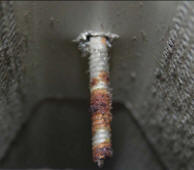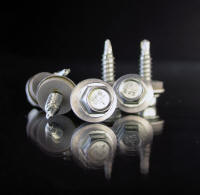| The
days of the chilly Victorian swimming baths are long gone; swimming pools
are now found in leisure centres or spas with warm, humid environments
boasting whirl pools, saunas and steam rooms. This change in use has had a
profound affect on the fabric of the structures in which swimming pools are
housed. |
| The
air temperature in pool halls is generally held around 1°C above the water
temperature. As the building is heated up and cooled down on a daily basis,
a condensation cycle tends to occur every 24 hours. Due to the high levels
of chlorine used in modern pool environments, water vapour saturated with
Chlorine will condense on cool surfaces, including roof and wall cavities,
as well as other important construction components that are not protected by
an effective vapour barrier. Chloride salts are left behind when the vapour
evaporates as temperatures rise again. Left in place, these salts can start
to attack the metal surface and cause stress corrosion cracking (SCC). |
| SCC is
a type of localised cracking in the component material which is defined by
fine cracks that can spread rapidly, leading to failure. Steel components,
under load in such environments, release hydrogen atoms produced as a
by-product of the corrosion mechanism. These atoms pass through the
crystalline structure of the metal, sometimes causing microscopic cracks to
form. Over time, these cracks can combine to cause a sudden tensile failure
in the product. |
| In harsh swimming
pool environments, SCC can occur if the correct grade of stainless steel is
not specified. In recent years, fasteners made from 304 and 316 grade
austenitic stainless materials were used above the vapour barrier. Further
research has been conducted to understand the wider effects of chloride salt
deposits attacking the protective "skin" of Chromium Oxide layers of under
load components. The research has indicated possible component failure,
particularly within the pool atmosphere. |
 |
| SCC is
not visible to the naked eye, and is therefore hard to diagnose, unlike the
normal ‘red rusting’ associated with carbon steel. In addition, these
vulnerable components are often hidden from view within cavities, where
there is no opportunity for regular inspection and cleaning. |
|
Correct specification |
| The
Nickel Development Institute (NDI) publication ‘Stainless steel in swimming
pool buildings’ advises that stainless steels which are susceptible to
stress corrosion must not be used for components which are classed as
‘safety critical’. Handrails, suspended ceiling hangers, staircases and
structural fasteners fall into these categories. |
| SFS intec has been
monitoring stress corrosion cracking and has developed a range of super
austenitic stainless steel fasteners, in line with recent published findings
by the British Stainless Steel Association and the NDI. These corrosion
resistant fasteners are made of 1.4547 grade "super austenitic" stainless
steel, specifically for swimming pools and other extreme applications.
|
 |
| The fasteners are
also designed so that their thermal conductivity is much lower than that of
a normal low alloy carbon steel fastener, thus reducing the risk of
condensation forming on the fastener. |
|
Managing stress corrosion cracking |
|
Corrosion can be controlled effectively by a
combination of good design, correct selection of SCC resistant materials,
and effective swimming pool environment management, maintenance and
inspection. SFS intec recommend that grade 1.4547 steel fasteners are used
on the pool atmosphere side of an effective vapour barrier, to maintain a
secure seal over the useful life of the building and protect the roof
cavity. Many new pool structures are specified with timber or Glulam beams
that are inherently corrosion resistant; where steel sections are used,
powder coating or other long life coatings are required to protect exposed
surfaces.
|
| Whilst
stress corrosion cracking is most common in swimming pool halls, there are a
number of other environments where it needs to be taken into consideration.
Facilities such as bleaching plants, laundries, water treatment plants and
PVC manufacturing factories all use, and can produce, high levels of
airborne Chlorine-rich water vapour. Where a condensation problem exists,
caused by poor ventilation or inadequate insulation, salts will be left on
vulnerable areas. Components used at motorway flyovers, junctions, linings
and tunnels can also be affected when saturated by spray from nearby road
surfaces that are heavily exposed to winter salt treatments. |
|
Always keep the internal atmosphere in mind |
| As
with any building, due consideration needs to be given to the internal
atmosphere and products specified in swimming pool developments. In harsh
environments where SCC can occur, materials such as super austenitic grade
1.4547 steel, offer a safe solution. |
| If you
would like further information on stress corrosion cracking and SFS intec’s
range of austenitic stainless steel fasteners then please contact Peter
Reilly at SFS intec; telephone 0113 208 5500. |